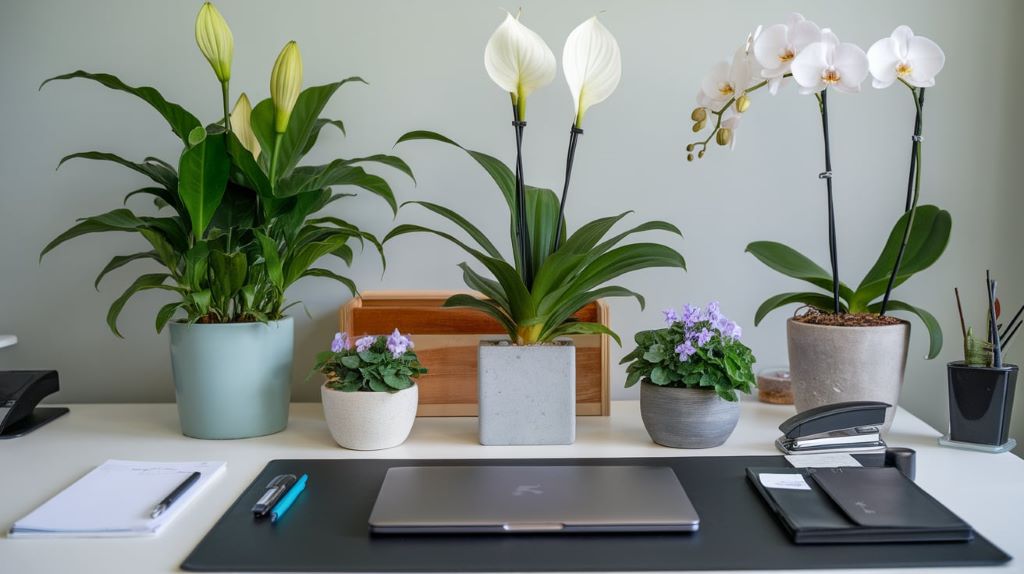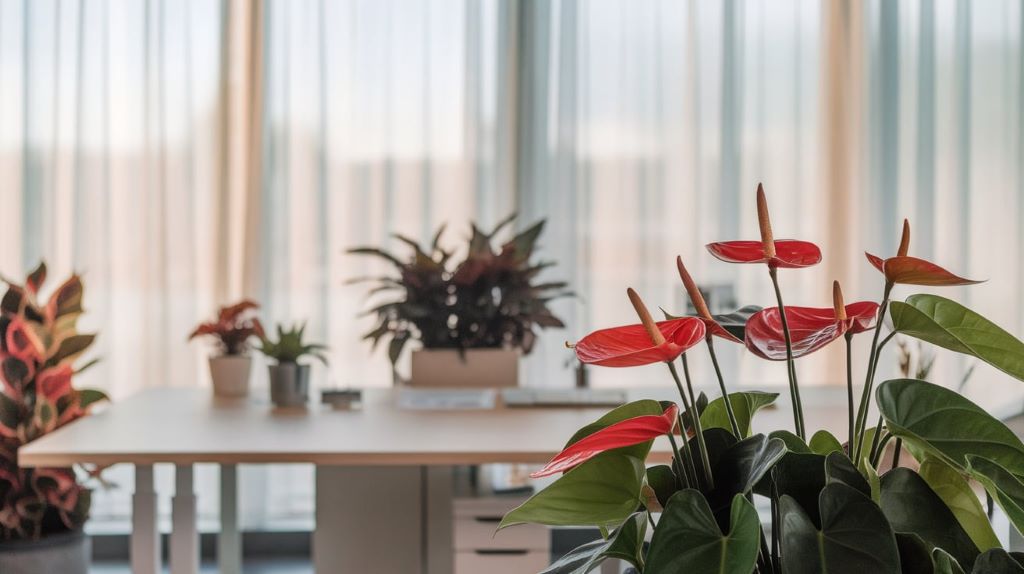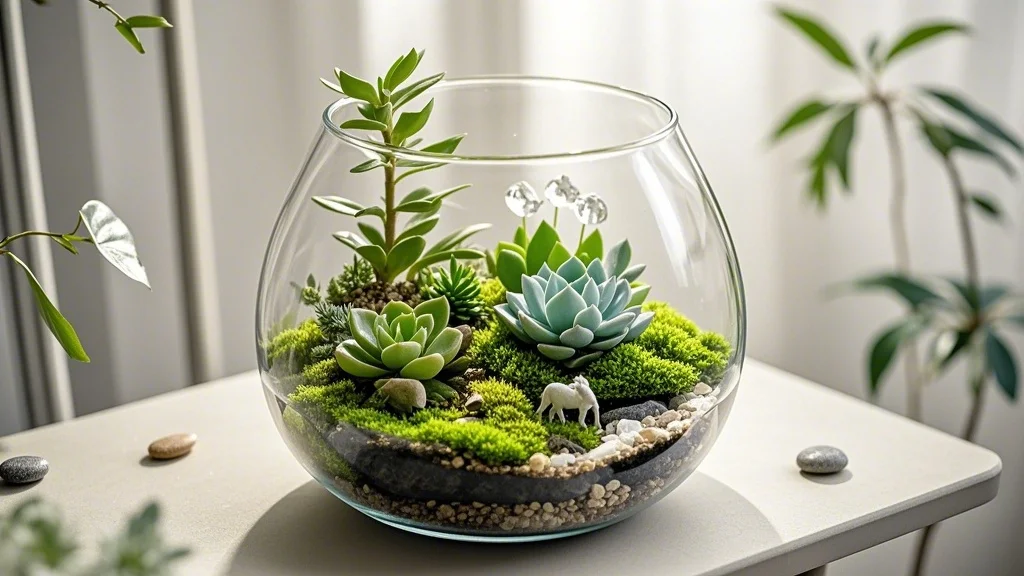Bringing flowering plants into the office environment does more than just add a splash of color to an otherwise mundane workspace. These natural elements can transform the atmosphere, boost productivity, reduce stress, and improve air quality. However, not all flowering plants can thrive under the artificial lighting and variable temperatures common in office settings. This guide explores the most resilient and beautiful flowering plants specifically suited for office environments, helping you select the perfect blooming companions for your workspace.
Contents
Why Choose Flowering Plants for Your Office?
Before diving into specific plant recommendations, let’s understand why flowering plants make excellent additions to any office:
- Visual appeal: Colorful blooms provide a welcome contrast to typical office decor
- Mood enhancement: Studies show flowering plants can reduce stress and anxiety
- Air purification: Many flowering plants filter common office pollutants
- Productivity boost: Research indicates plants in workspaces can increase productivity by up to 15%
- Improved focus: Natural elements help combat mental fatigue during long workdays
Key Considerations for Office Plant Selection
When selecting flowering plants for an office environment, consider these factors:
- Light conditions: Most offices have limited natural light
- Maintenance requirements: Low-maintenance options are ideal for busy professionals
- Size and growth habits: Choose plants that won’t outgrow their designated space
- Allergen potential: Consider colleagues with sensitivities
- Humidity and temperature tolerance: Offices often have dry air and fluctuating temperatures
Top Flowering Plants for Office Environments

1. Peace Lily (Spathiphyllum)
Light requirements: Low to medium indirect light
Maintenance level: Low
Bloom frequency: Year-round with proper care
Peace lilies top our list for good reason. These elegant plants produce distinctive white spathes (often mistaken for flowers) that brighten any workspace. They’re remarkably adaptable to office lighting conditions and can thrive under fluorescent lights. Peace lilies also excel at removing common office air pollutants like benzene and formaldehyde.
Care tips:
- Water when the top inch of soil feels dry
- Tolerates inconsistent watering better than most flowering plants
- Leaves will droop when thirsty, making it easy to know when to water
- Prefers temperatures between 65-80°F (18-27°C)
2. African Violet (Saintpaulia)
Light requirements: Medium indirect light
Maintenance level: Medium
Bloom frequency: Can bloom continuously with proper care
African violets are compact powerhouses that produce charming purple, pink, or white blooms even under office lighting. Their small size makes them perfect for desktops or small shelves. With proper care, these plants can flower nearly year-round, providing a consistent pop of color.
Care tips:
- Keep soil consistently moist but not soggy
- Water from the bottom to avoid leaf spotting
- Prefers stable temperatures between 65-75°F (18-24°C)
- Benefits from specialized African violet fertilizer
3. Anthurium
Light requirements: Medium indirect light
Maintenance level: Low to medium
Bloom frequency: Year-round with proper care
With their glossy, heart-shaped blooms in vibrant red, pink, or white, anthuriums make striking office plants. What appears to be the flower is actually a modified leaf called a spathe, which can last for weeks or even months. These tropical beauties adapt well to office environments and provide long-lasting color.
Care tips:
- Allow the top inch of soil to dry between waterings
- Appreciates higher humidity but tolerates drier office air
- Fertilize lightly every few months
- Avoid direct sunlight which can scorch leaves
4. Orchids (Phalaenopsis)
Light requirements: Medium indirect light
Maintenance level: Medium
Bloom frequency: Seasonal, blooms last 2-3 months
Phalaenopsis orchids, also known as moth orchids, are surprisingly well-suited to office environments. Their exotic blooms can last for months, providing extended visual interest. While they have a reputation for being difficult, office-friendly varieties like Phalaenopsis are actually quite adaptable.
Care tips:
- Water sparingly, allowing the specialized orchid medium to dry between waterings
- Prefers bright, indirect light but can adapt to office lighting
- Reblooms when exposed to slightly cooler nighttime temperatures
- Use specialized orchid fertilizer at quarter strength
5. Flowering Begonia
Light requirements: Medium to bright indirect light
Maintenance level: Medium
Bloom frequency: Seasonal to year-round depending on variety
Begonias offer both beautiful foliage and delicate blooms, making them excellent two-in-one office plants. Varieties like the wax begonia or rex begonia can flower under good office lighting conditions. Their colorful flowers range from white to pink to deep red.
Care tips:
- Keep soil lightly moist but not waterlogged
- Appreciates humidity but adapts to office conditions
- Pinch back spent blooms to encourage more flowering
- Fertilize monthly during growing season
6. Kalanchoe
Light requirements: Bright indirect light
Maintenance level: Low
Bloom frequency: Seasonal, blooms last 2-3 months
Kalanchoe plants produce clusters of small, vibrant flowers in red, orange, yellow, or pink that can brighten any office space. As succulents, they’re incredibly forgiving of neglect and irregular watering schedules, making them perfect for busy professionals.
Care tips:
- Allow soil to dry completely between waterings
- Thrives in typical office temperatures
- Requires a period of darkness to trigger reblooming
- Minimal fertilizer needs
7. Christmas Cactus (Schlumbergera)
Light requirements: Medium indirect light
Maintenance level: Low
Bloom frequency: Seasonal (winter)
Despite its name, the Christmas cactus can be enjoyed year-round for its interesting segmented foliage. Come winter, it produces stunning tubular flowers in pink, red, or white. This plant is exceptionally long-lived, with some specimens thriving for decades.
Care tips:
- Water when the top inch of soil is dry
- Tolerates dry office air well
- Needs 12-14 hours of darkness daily for 6-8 weeks to trigger blooming
- Keep away from heating vents and cold drafts
8. Bromeliads
Light requirements: Medium indirect light
Maintenance level: Low
Bloom frequency: Once per plant, but blooms last 3-6 months
Bromeliads bring tropical flair to office environments with their exotic, colorful flower spikes that can last for months. While each plant blooms only once, the display is long-lasting and spectacular. After blooming, the mother plant will gradually die but produce offsets (pups) that will eventually bloom themselves.
Care tips:
- Water the central cup (tank) rather than the soil
- Tolerates dry air and irregular watering
- No need for fertilizer during blooming
- Can thrive under fluorescent office lighting
9. Flowering Maple (Abutilon)
Light requirements: Bright indirect light
Maintenance level: Medium
Bloom frequency: Year-round with adequate light
Despite its name, flowering maple is not related to true maples. These charming plants produce bell-shaped blooms in orange, yellow, or red that hang delicately from their branches. With proper pruning, they can be maintained as compact office plants.
Care tips:
- Keep soil consistently moist but not soggy
- Benefits from regular feeding during growing season
- Pinch back growth to maintain compact shape
- May need supplemental lighting in darker offices
10. Lipstick Plant (Aeschynanthus)
Light requirements: Medium indirect light
Maintenance level: Medium
Bloom frequency: Multiple times per year with proper care
The lipstick plant earns its name from its distinctive red flowers that emerge from dark buds resembling a tube of lipstick. As a trailing plant, it works beautifully in hanging baskets or on shelves where the stems can cascade down. The dramatic blooms provide excellent visual interest in office settings.
Care tips:
- Allow soil to dry slightly between waterings
- Prefers higher humidity but adapts to office conditions
- Fertilize monthly during growing season
- Prune after flowering to encourage bushier growth
Creating Optimal Growing Conditions in the Office
Even the hardiest office plants will perform better with a few simple adjustments:
Lighting Solutions
- Position plants near windows when possible, but avoid direct sunlight which can scorch leaves
- Use supplemental grow lights for offices with minimal natural light
- Rotate plants regularly to ensure even growth
- Clean dust from leaves monthly to maximize light absorption
Watering Strategies for Office Plants
- Set calendar reminders for watering schedules
- Use self-watering planters for consistent moisture during busy periods or vacations
- Check soil moisture before watering rather than following a strict schedule
- Use room temperature water to avoid shocking plant roots
Temperature and Humidity Considerations
- Keep plants away from vents, radiators, and drafts
- Group plants together to create microenvironments with higher humidity
- Consider a small desktop humidifier for particularly dry office environments
- Use pebble trays filled with water beneath plants to increase local humidity
Troubleshooting Common Office Plant Problems
Lack of Blooms
- Insufficient light: Move to a brighter location or add supplemental lighting
- Improper temperature: Ensure plants aren’t exposed to temperature extremes
- Nutritional deficiencies: Implement a regular fertilizing schedule
- Incorrect dormancy period: Some plants require specific light/dark cycles to bloom
Pest Management in Office Settings
- Inspect new plants thoroughly before bringing them into the office
- Wipe leaves regularly with a damp cloth to remove dust and detect pests early
- Use insecticidal soap for minor infestations (apply after hours)
- Isolate affected plants immediately to prevent spread
Leaf Problems
- Brown leaf tips: Often indicates dry air or inconsistent watering
- Yellow leaves: May signal overwatering or nutrient issues
- Pale, leggy growth: Usually indicates insufficient light
- Leaf drop: Could be caused by temperature fluctuations or watering issues

Conclusion
Incorporating flowering plants into your office environment brings numerous benefits beyond mere decoration. The right selections can thrive under typical office conditions while providing beautiful blooms that enhance mood, productivity, and air quality. From the low-maintenance peace lily to the exotic appeal of orchids, there’s a flowering office plant suited to every workspace and care level.
Remember that even the most resilient plants require some attention. Establishing a simple care routine and understanding each plant’s specific needs will ensure your office blooms remain vibrant throughout the year. With this guide, you’re well-equipped to transform your workspace into a flourishing indoor garden that both you and your colleagues can enjoy.
Additional Resources
- Consider downloading plant care apps to help track watering schedules
- Join online plant communities for specific advice on office plant care
- Check with your facilities management about any restrictions on bringing plants into the workspace
- Explore local nurseries that specialize in indoor plants for personalized recommendations
By selecting the right flowering plants for your office environment, you’ll create a more vibrant, healthy, and productive workspace that blooms with possibility.








